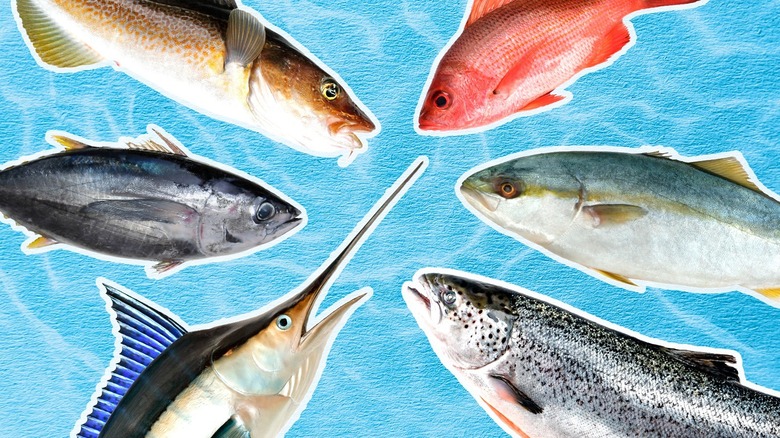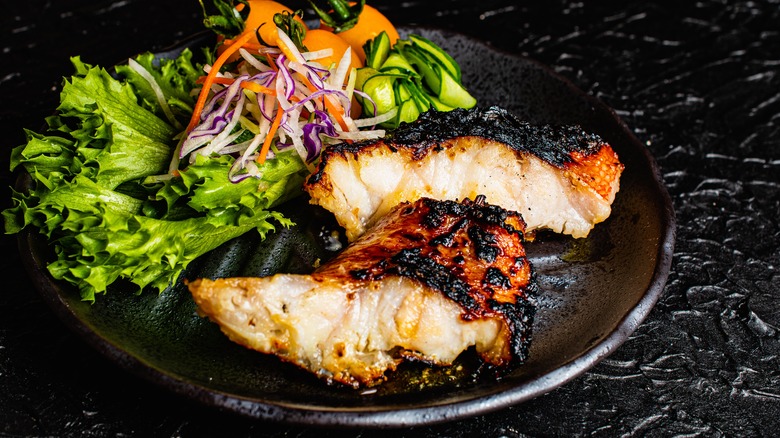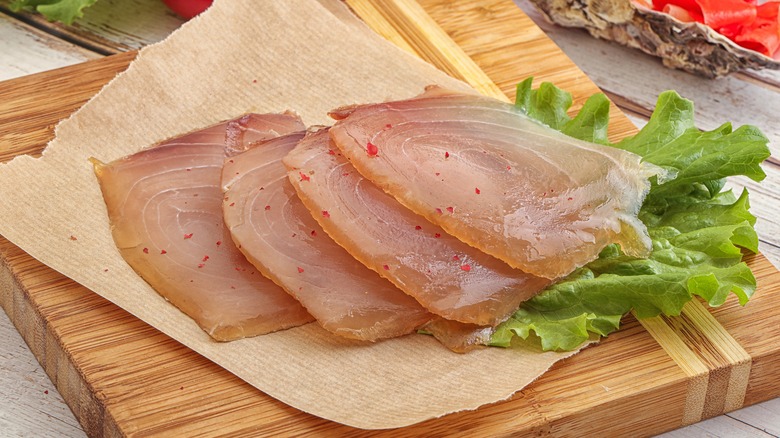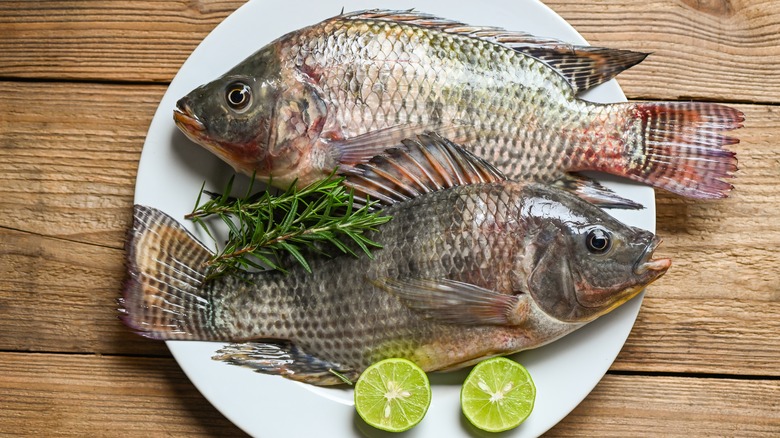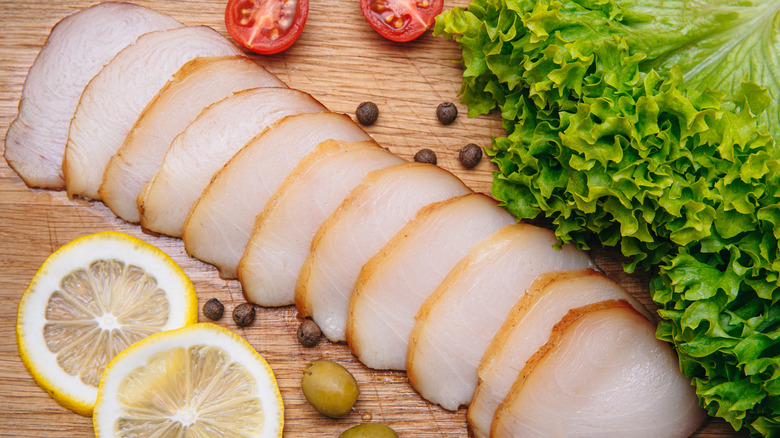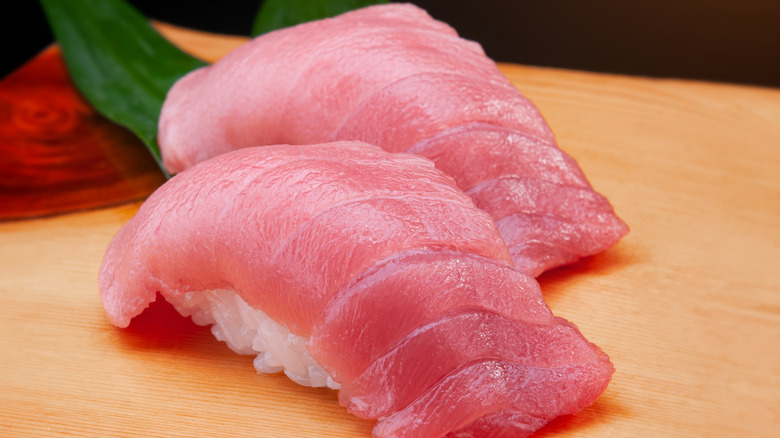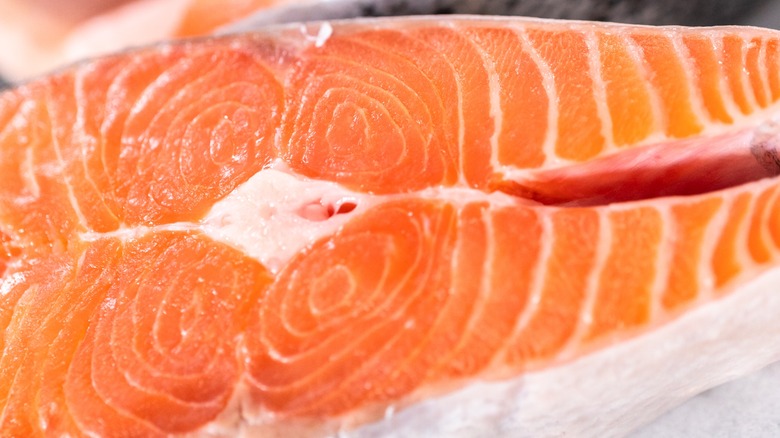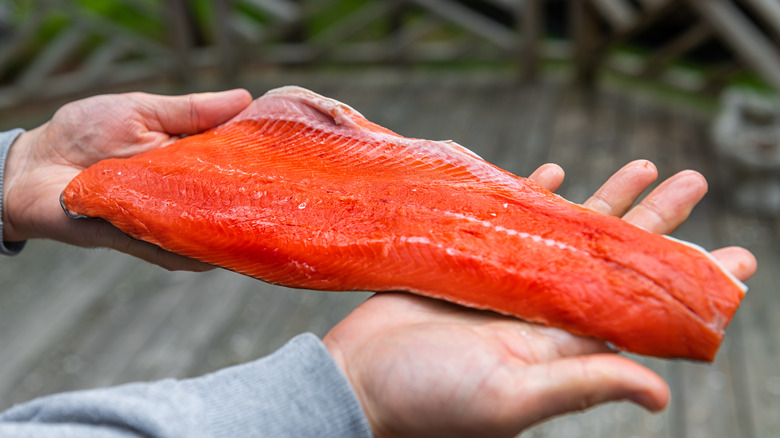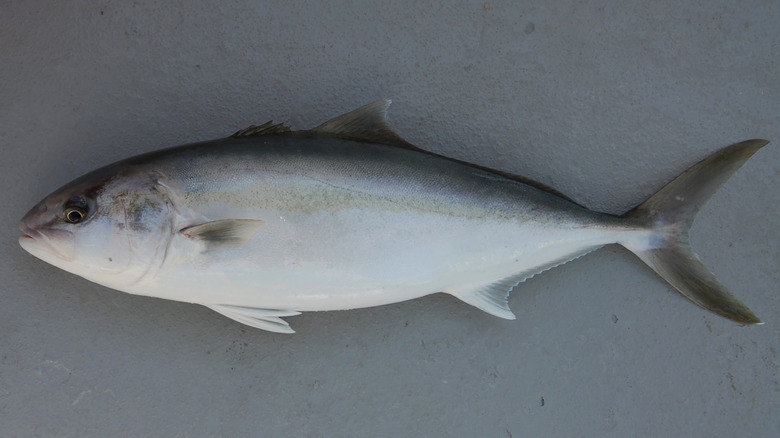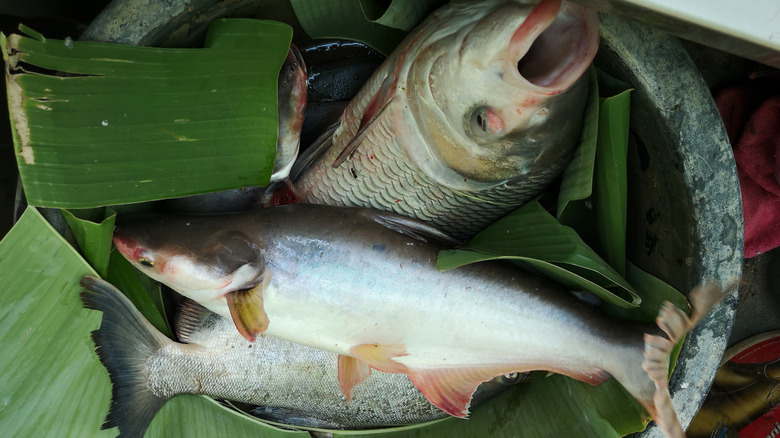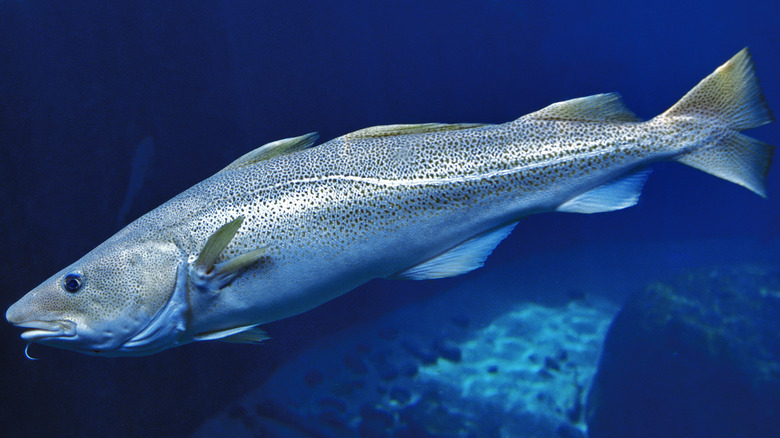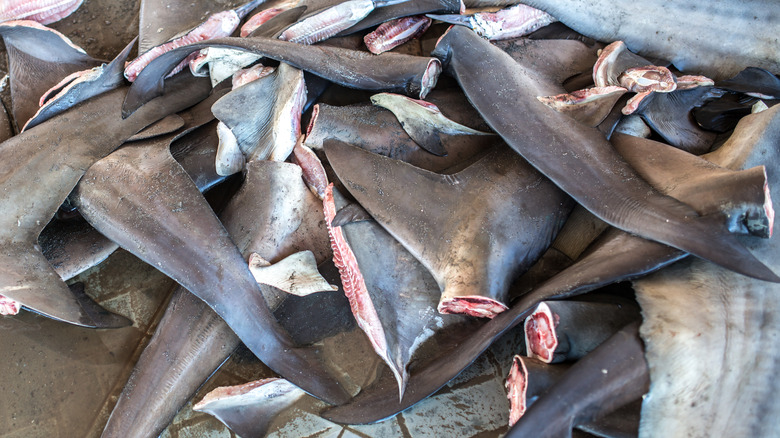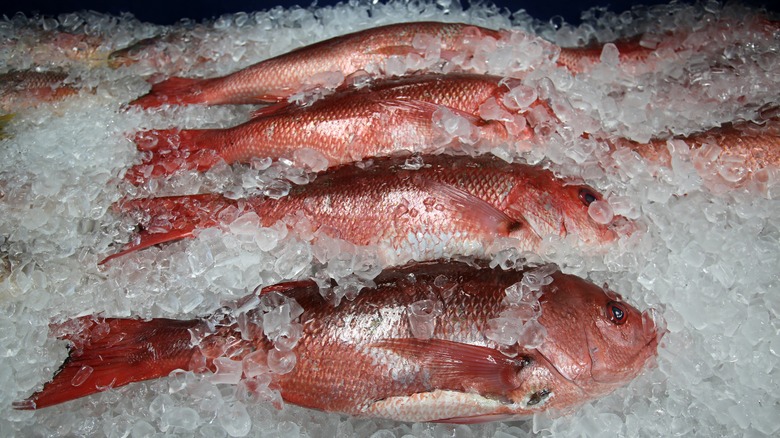13 Types Of Fish You Should Think Twice About Before Buying
We know that experts recommend adding fish to your diet to increase your heart health and slow the mental effects of aging, thanks to minerals, vitamins, and Omega-3 fatty acids. It's also believed fish helps prenatal and natal cognitive and physical development. So, let's eat more fish; but what's stopping us?
Finding the right fish can be problematic when simultaneously trying to do right for yourself and the planet. We haven't been kind to the marine environment, so consumers should avoid some fish for health reasons, such as high concentrations of heavy metals or other, more unseemly properties. In other cases, overfishing or questionable fishing techniques have put marine populations at risk. But the oceans are vast, and in many cases, a species overfished in one place has a healthy population elsewhere and vice versa. So, knowing what your fish is, where it came from, and how it was caught or farmed can help you make better purchasing decisions.
In that spirit, we've compiled a list of fish that should give you pause, either for health implications for yourself, and your family, or their environmental impact. These factors don't mean that you shouldn't buy them, but consider the information at hand to make an informed purchase.
Gulf Golden Tilefish
Tilefish range the length of the East Coast of the U.S. and the Gulf of Mexico. They prefer the warm current that flows deep near the edge of the continental shelf, and they're colorful fish with green, yellow, and white markings that gain them the title of "clown of the sea." Their diet is mainly crustaceans, which lend their flavor to the fish, making it reminiscent of lobster or crab, which increases their market desirability. Unfortunately, the golden tilefish found in the Gulf has almost eight times the mercury content of the same species found in the Atlantic.
With mercury in seafood being a cause for concern, the National Oceanic and Atmospheric Administration (NOAA) conducted a study between 2010 and 2016 to identify locations of high mercury in the Gulf and species affected by that mercury. The usual suspects, such as apex predators and pelagic species, topped the list of fish with high levels of mercury, but the tilefish doesn't fit either of those models. Hence, the source of the mercury concentration remains murky.
Marlin
Marlin is an apex predator, controlling other populations by consuming numerous smaller species for its dietary needs. The unfortunate side effect for humans with predators such as the marlin is that mercury, often in acceptable amounts in the smaller fish, accumulates in the marlin's body and often reaches dangerously high levels for human consumption, as explained by Scientific American.
Another aspect for consideration is their population. In the case of location and fishing methods determining the sustainability of a population, blue marlin are considered overfished in the Gulf of Mexico, according to the PEW Charitable Trusts. Throughout the rest of the article, the term overfished means that the catch rate exceeds the species' reproductive rate, with the population depleted to a level of concern. But, blue marlin in the Pacific Ocean is considered a "smart seafood choice" by NOAA and doesn't suffer from overfishing. In the case of the Gulf marlin, surface long lines that can stretch up to 30 miles are used in fishing targeting other species, and marlin is often unintentional bycatch from the technique. In the Pacific fisheries, regulations are in place for tuna and swordfish fishing that minimize marlin as an accidental target.
Chinese farm-raised tilapia
There's no need to completely avoid tilapia if you check its country of origin labeling. Honduras, Mexico, and Ecuador are all responsible producers of fish. These countries have regulations in place to farm tilapia in ways that mitigate their impact, including minimizing fish meal in their food and treating the wastewater. Indoor farming in filtered, recirculating tanks is a preferred method, minimizing external environmental impact and minimizing inhumane damage to predators and potential for escape. We'll see why these are important next.
Chinese farm-raised tilapia presents a host of issues. First is the predominant farming method, which is ponds. These shallow water pens concentrate the fish citizenry and, with that, their waste. These ponds are often located in flood-prone areas, which increases the opportunities for the tilapia to escape. When they do, they dominate food supplies and other resources that local species depend on. There's also evidence of illegal antibiotic and antimicrobial use, and antibiotic resistance in the fish is also suspected.
Escolar
Before we go down a long path of fish with sustainability issues, let's talk about one people might not be meant to eat. Escolar is an incidental bycatch from the tuna fishing industry that has been on restaurant menus since the 1990s. Its latest branding incarnation appears on sushi menus as "white tuna." There are issues with escolar, though; the maximum amount of escolar humans should eat is 6 ounces in one sitting, according to California Sea Grant.
The reason for this lies in Escolar's other names, like (castor) oil fish or butterfish, in addition to the white tuna misnomer. These names derive from escolar's laxative or purgative properties caused by the fish's body makeup. About 20% of an escolar's body weight is composed of waxy esters that are wholly indigestible and produce gastric problems in folks who eat too much. Because of these properties and frequent, deceitful mislabeling, Italy and Japan have banned the sale of this fish.
Pacific bluefin tuna (even farmed)
Diner prize bluefin tuna for its fatty flesh, and you may know it by its sushi name, Toro or Hon-Maguro, or Otoro for its even fattier belly portion. That wasn't always the case, as people in the U.S. once considered bluefin an unvalued sport fish with little value to humans. Pressure on bluefin populations exploded as they became more valued on the plate. However, population estimates of Pacific bluefin are now at less than 10% of their original numbers, notes Sustainable Sushi. Atlantic bluefin populations were in the same boat, but management initiatives from the NOAA have shifted the pressure, and those population counts appear to be improving.
So what's the next logical choice? Farming Pacific tuna to take the pressure off the wild population seems like a good move, right? It turns out that farming apex predators still puts pressure on the environment, with bluefin requiring about 20-to-1 input of fish protein to pounds of tuna produced. Also, farmed tuna are often not raised from an egg but are wild-caught juveniles raised to adulthood, which does little to ease the pressure on the wild population.
Some farmed salmon
Salmon is the second most consumed seafood in the U.S., according to the National Fisheries Institute, sitting squarely between shrimp and canned tuna. Of the salmon consumed worldwide, the Marine Stewardship Council (MSC) states about 72% of it is farm-raised.
Farming can be good or bad, depending on the farm's location, regulations, and the fish's treatment for diseases and parasites. Best practices state the best farm-raised salmon come from indoor facilities with recirculating water systems that treat the wastewater. Farmed salmon are almost exclusively Atlantic salmon, differing genetically from wild Atlantic salmon, and indoor facilities make escape and intermingling of the species almost impossible.
The next choice is net pens, which can be good or bad depending on location. Some farms in the U.K. are well-rated, while others in northwest Scotland are not. Newfoundland and specific areas of Norway are in the same rating boat. Look for farmed salmon from Nova Scotia, areas of Chile, British Columbia, and other regions of the U.K. for better choices that use more sustainable practices.
Some wild salmon
If keeping track of which farmed salmon to buy is confusing, get ready for wild salmon. The first thing to know is that any wild salmon from the U.S. are from the Pacific. NOAA manages these fisheries under two auspices, the Endangered Species Act (ESA), which protects certain species, and the Magnuson-Stevens Act (MSA), which regulates commercial and recreational fishing to preserve healthy levels. Four of the five salmon species under their umbrella have populations covered under the ESA. These populations are surveyed down to the granular level of which river they spawn in and are not available for catch or sale.
Of those covered under the MSA, location is everything. Most wild salmon from Alaska is from an MSC-certified fishery, but the further south you go, the more you run into questions. There are many nuances to what makes a good salmon or bad that exceed the available space here, but summarizing Seafood Watch's guidelines, we can say avoid Chinook from Puget Sound, Columbia River Coho, and Chinook or coho from southern British Columbia, and you should be in safe territory.
Amberjack
Amberjack might be unfamiliar to you by its common name, but the sushi menu name of some of its species, hamachi, or yellowtail, might be more friendly. Not all amberjack is worrisome; the Atlantic Greater Amberjack (kanpachi) population is not a victim of overfishing, per the NOAA, and the Gulf population is bouncing back after adjustments to reduced catch rates.
True hamachi, the Japanese amberjack, poses some issues, though. According to Sustainable Sushi, wild Japanese amberjack populations are on the decline, and the seemingly good alternative of farm-raising them is problematic for a handful of reasons. Amberjack are predators and eat fish, of which it can take 8 pounds to yield 1 finished pound of hamachi. Additionally, farmed hamachi are taken from wild stock, and every fish taken for farming will never reproduce in the wild to rebuild the population. Finally, the net pens they are raised in concentrate the fish. Diseases spread quickly in environments like this and can spread to other populations in the event of an escape. Concentrated pen farming also turns the ocean floor below the pens into a sewage dump. Other countries' farming techniques countries don't utilize this method, so check the country of origin when buying.
Vietnamese farmed catfish
Often marketed as basa or swai, Asian catfish gained popularity on American tables because of its low cost and light flavor. It's a sturdy fish that stands up to grilling but retains a somewhat delicate texture on the palette. It can also be an environmental train wreck.
The issues arise from the methods used in their farming. We've already seen how pond farming presents sanitation and health problems, likewise with net pen farming. With most of the pens located along the Mekong River, wastewater discharges directly into the river. This gives rise to many social and environmental issues. According to Seafood Watch, there's also evidence of chemical and antibiotic use that finds its way into the river via illegal dumping. Vietnam is increasing its eco-certifications to counter current and past mismanagement, so hopefully, our recommendation to probably avoid this fish will change. In the meantime, according to the World Wildlife Federation (WWF), look for basa packaged with the Aquaculture Stewardship Council label to avoid this.
Atlantic cod
Cod is the backbone of classic fish 'n chips, and cod is a common variety of fish in general. It was also the backbone of New England fisheries before the North American Atlantic cod population collapsed in 1992. Overfishing, intrusion from longer-ranging fishing boats, and technological advances in techniques were all culprits in a hundreds-of-years-old industry. Fishery mismanagement is also to blame, as cod were frequent bycatch with high mortality rates from fishing for other species. As NPR reported in 2022, Atlantic cod populations may be seeing a bounce-back, but only time will tell. At the same time, the Pacific cod fisheries are doing quite well, particularly from any of the West Coast states, Alaska, or British Columbia.
So, cod isn't off the table; just ensure that the fish you're buying comes from a sustainable source. Pacific cod from the U.S. or Canada is fine, and Atlantic cod can be okay, given a few considerations. First, avoid Canadian Atlantic cod, then, try to ensure the source is either Georges Bank or the Gulf of Maine, and finally, ensure that the fish from those locations was caught with hand lines or hand-operated poles.
New Zealand orange roughy
Also known by the charming name slimehead, this fish is better known by its more marketable label; New Zealand orange roughy. It's a mild white fish with delicate flesh and some notes of shellfish. So, it's an inoffensive fish, which led to its popularity and subsequent overfishing in the 1990s. It currently presents one of the most frustrating challenges of identifying what's good and bad when buying seafood; conflicting reports and ratings.
The MSC regards the New Zealand orange roughy fishery as a success story, progressing from being threatened to being the first MSC-certified fishery in 2016. Conversely, Seafood Watch slapped an "Avoid" label on many of the zones of the same fishery. The reasoning for Seafood Watch's designation does not lie in overfishing or from an overfished population, and there's even precious little bycatch. The problem lies in the fishing methods. Orange roughy is a deep-water fish frequently caught by bottom trolling. Because the fish share a neighborhood with coral and deepwater sponges, the bottom-scraping nets cause unintentional damage to these neighbors and stress the ecosystem. Erring on the side of caution might be the better course.
Shark
According to a 2021 Greenpeace article, 100 million sharks are killed annually through accidental bycatch, finning, and a general disregard for the species. But sharks are also apex predators and keep a check on populations lower in the food chain and help to balance their ecosystems, which is incredibly important.
"Finning" is the practice of removing the fins from a shark, discarding the rest of the body, and selling or using the fins for medicinal, cancer-curing soup, despite studies showing that the monomethyl mercury content of most sharks could cause cancer rather than cure it. In the U.S., the Shark Fin Sales Elimination Act became law in late 2022, banning the sale or harvesting of shark fins. Canada, too, passed legislation in 2019 prohibiting the import or export of shark fins, bolstering their existing finning ban. So, until shark kills subside and populations can increase, it's best to leave sharks alone.
Red snapper
American red snapper (the species) is a confusing fish to buy responsibly. The catch location is a good determiner, or it should be. Snapper caught in the U.S. portion of the Gulf of Mexico is listed as a Good Alternative by Seafood Watch because, while the population is considered depleted, it's not subject to overfishing as it was in the past. But the same fish, from the same body of water, caught in Mexico carries an Avoid listing from the same group because Mexico doesn't maintain the strict limits called for in the Magnuson-Stevens Act, updated in 2018 to help rebuild the red snapper fisheries.
But multi-national policies are not the only issues that present confusion. Go around Florida to the Atlantic side, and red snappers caught on the same vertical lines used in the Gulf have an Avoid rating. Atlantic populations have undergone overfishing and are considered overfished, making a recovery challenging, if not impossible. If you can keep all this straight, ask your fishmonger where and how your red snapper was caught when buying.
